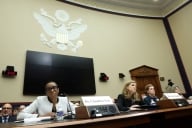You have /5 articles left.
Sign up for a free account or log in.
The challenge of Internet-based transparency was brought home to me the other day in a Babson College business school lecture hall.
Babson’s classrooms are enabled with wireless Internet access; an instructor faces a room filled with flipped-open laptops, as students take class notes and, as I learned, surf the Web.
After teaching my first class, I found a student’s e-mail waiting for me. Sent exactly three minutes after the class finished, it included a question about the revenue split between Apple’s iTunes and the Big Five record companies, a topic covered in my lecture on new media management. The student had information from the Internet -- downloaded during class -- that differed slightly from what I had been presenting. What did I think?
What did I think? I answered his question by sending him -- electronically -- some clarifying source material on the topic. And then I paused, struck by the implications of our interchange. In a wireless classroom, students can make real-time comparisons with a professor’s presentation; they can cross-check facts, shop for second opinions, research the literature in cyber-space on a given topic.They are armed with a powerful new tool and that power is bottom-up, not top-down, in nature.
Before the next class, a few of my students confirmed that this silent multi-tasking was common practice. One young woman explained how many students used the Web as a virtual encyclopedia during lectures.
“Whenever there’s a new concept or term, I Google it,” she said. "When you mentioned Wikipedia in the last class, I went to their site and looked at it. I’d never been there before."
Of course that’s the upside. Online students could also very well be checking out the NCAA basketball tournament scores, e-mailing or instant messaging friends, playing games, and pursuing other distractions. In some law and business schools -- where wireless access is ubiquitous -- this new open door to the Internet has apparently raised professorial hackles, with some instructors banning connected laptops during class time.
But with most American college campuses embracing wireless, and with Web-connected devices growing smaller, this evolution to the Internet-transparent classroom is well under way as part of a transformed educational future. (Duke University gave its freshmen iPods last year and encouraged them to record lectures). The immediate availability of vast amounts of information, and the ability to make perfect infinite copies, to communicate, and to distribute instantaneously will, by necessity, alter the ways we learn and teach.
Transparency holds out the promise of a deeper, richer and more democratic educational experience, but also an implied challenge to the traditional academic order.
The late Nobel Prize-winning economist Herbert Simon had it right: the verb “to know” used to mean having information stored in one’s memory – and it now means having access to that information and knowing how to use it. Maintaining the instructor’s authoritative “sage on the stage” role will grow more difficult. Instead, teachers at all levels will increasingly be called on to help students navigate this Alexandrine-like Web library and a new informational literacy will be needed, with an emphasis on judgment, synthesis, clear thinking, and what author Robert McHenry calls a “genial skepticism” about the veracity and quality of the information a mouse-click away.
It’s not only educators who confront the challenge of transparency. Mainstream journalists now find bloggers and amateur editors fact-checking their copy in real time; it’s no wonder that more instances of plagiarism and shaky journalistic practice are being exposed.
Corporations and the government aren’t exempt either. Authors Don Tapscott and David Ticoll use the term “naked corporation” to describe how the Web makes businesses more visible (and possibly more accountable) to shareholders, customers, employees and society. And more and more government activity is migrating to the Internet, allowing for intense public scrutiny (which should, over time, make public officials more accountable to taxpayers and voters.)
During my Babson teaching stint I tried acknowledging, and using, this instant Internet connection whenever it made sense. For example, I encouraged students to surf to a Google Local beta site I’d mentioned; I asked the class to double-check some of my estimates against Web data, and when one of my lectures wandered slightly off course to touch on the theology of Pierre Theilhard de Chardin I found myself hoping that a student or two might explore what the Web offered on the Jesuit thinker.
How will teaching, and learning, evolve in wireless classrooms? The potential for disruption and distraction will exist, side-by-side with the prospects of an enhanced and informed dialogue between teachers and students. Let’s hope that engaged connection is the model for the future.








